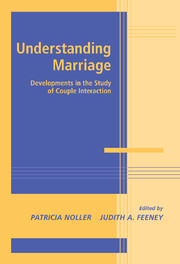Book contents
- Frontmatter
- Contents
- Contribitors
- Introduction
- SECTION ONE THE EFFECT OF COGNITION ON INTERACTION PATTERNS
- Introduction to Section One
- 1 Thought and Action: Connecting Attributions to Behaviors in Married Couples' Interactions
- 2 Self-Evaluation Motives in Close Relationships: A Model of Global Enhancement and Specific Verification
- 3 Competition in Romantic Relationships: Do Partners Build Niches?
- 4 Cognition and Communication during Marital Conflict: How Alcohol Affects Subjective Coding of Interaction in Aggressive and Nonaggressive Couples
- SECTION TWO UNDERSTANDING THE IMPORTANCE OF POSITIVE INTERACTION
- SECTION THREE COPING WITH DISAPPOINTMENT, CRITICISM, AND BETRAYAL
- SECTION FOUR POWER, CONFLICT, AND VIOLENCE IN MARITAL INTERACTION
- Marital interaction at important transition periods
- SECTION SIX Interventions for strengthening relationships
- Conclusions
- Index
- References
1 - Thought and Action: Connecting Attributions to Behaviors in Married Couples' Interactions
Published online by Cambridge University Press: 25 July 2009
- Frontmatter
- Contents
- Contribitors
- Introduction
- SECTION ONE THE EFFECT OF COGNITION ON INTERACTION PATTERNS
- Introduction to Section One
- 1 Thought and Action: Connecting Attributions to Behaviors in Married Couples' Interactions
- 2 Self-Evaluation Motives in Close Relationships: A Model of Global Enhancement and Specific Verification
- 3 Competition in Romantic Relationships: Do Partners Build Niches?
- 4 Cognition and Communication during Marital Conflict: How Alcohol Affects Subjective Coding of Interaction in Aggressive and Nonaggressive Couples
- SECTION TWO UNDERSTANDING THE IMPORTANCE OF POSITIVE INTERACTION
- SECTION THREE COPING WITH DISAPPOINTMENT, CRITICISM, AND BETRAYAL
- SECTION FOUR POWER, CONFLICT, AND VIOLENCE IN MARITAL INTERACTION
- Marital interaction at important transition periods
- SECTION SIX Interventions for strengthening relationships
- Conclusions
- Index
- References
Summary
Causal and responsibility attributions made by married partners are a frequent subject of study by relationship researchers (Fletcher & Fincham, 1991; Holtzworth-Munroe & Jacobson, 1988; Manusov, 1990; Miller & Bradbury, 1995). Few studies have connected couples' attributions to the behaviors they use in response to those thoughts however (see Fincham, 1994). Because overt behaviors are likely to shape the climate for a relationship (Noller, 1992), investigating how thoughts may connect with action is important for understanding the role causal attributions play within marriage.
This paper focuses particularly on nonverbal cues exhibited by married partners. Goffman (1979) refers to nonspoken cues as part of a “glimpsed” world, often unarticulated but rich in social information (Ambady & Rosenthal, 1992). According to Noller (1992), “many messages having neutral words … [are] changed into positive or negative messages by … the nonverbal channels” (p. 50). The valence of messages has been found to differentiate satisfied from unsatisfied couples consistently, and much of the affective tone of messages is relayed via nonverbal means (Gottman & Levenson, 1992; Huston & Vangelisti, 1991). Because more highly valenced (very positive or very negative) behaviors are likely to instigate greater attribution making (Wong & Weiner, 1981), they should also result in behaviors that reflect the attributions given for a spouse's actions.
In the following pages, I discuss the importance of investigating nonverbal behaviors as both triggers of, and reactions to, attributions by married couples.
Information
- Type
- Chapter
- Information
- Understanding MarriageDevelopments in the Study of Couple Interaction, pp. 14 - 31Publisher: Cambridge University PressPrint publication year: 2002
References
Accessibility standard: Unknown
Why this information is here
This section outlines the accessibility features of this content - including support for screen readers, full keyboard navigation and high-contrast display options. This may not be relevant for you.Accessibility Information
- 10
- Cited by
